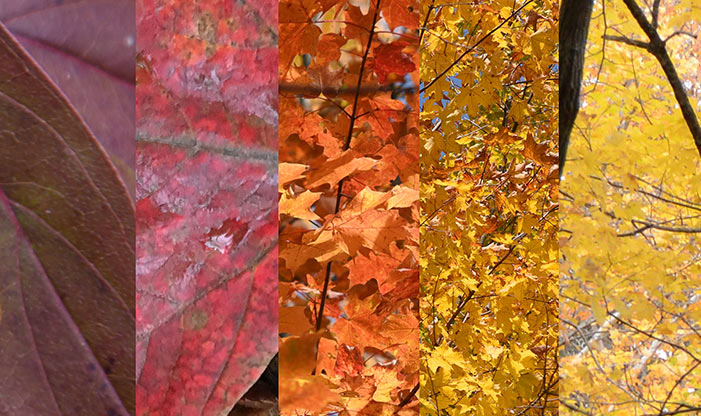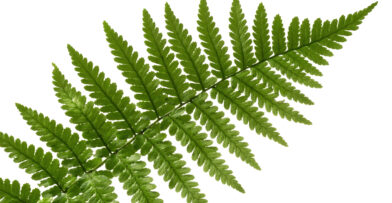Fall colors in Wisconsin provide a vast array of breathtaking views to witness at Schlitz Audubon. During September, October, and November, we watch trees transform from mostly green to a palette of fleetingly vibrant colors. Part of the fun of the season is the anticipation of not only which colors we will see, but how the environmental conditions will render these pigments before our eyes.
The most brilliantly colored autumn tends to be a product of sunny days, cooler nights, and average moisture. The colors we see often have more to do with the environmental factors of weeks ago, and the plants are responding to those prior variables. A hot fall or late summer, or one with less than average rain, tends to result in less brightly colored leaves. Extra rainfall tends to pull leaves from the trees earlier than usual.
Observational phenology science has provided a predictive cascade of which species succeed one another in changing colors every fall. Senior Ecologist Don Quintenz observes that when red maples begin to turn colors people often hypothesize that we will have an “early” fall. Red maples, however, are the first tree to turn at the Center every year. Our change begins with maples and sumacs and concludes with willows and tamaracks late in the season.
Photosynthesis and Fall Colors in Wisconsin
Chlorophyll is the producer of photosynthesis, a process during which chloroplasts take the energy of sunlight, combine it with water and carbon dioxide, releasing oxygen and creating sugar. Chlorophyll is green, providing the color in leaves throughout summer. Leaves, however, are not efficient in the cold of winter. Leaf cells would freeze, so plants have evolved to shed anything not entirely necessary leading up to cold weather. In that process of self-preservation, the sugars migrate to the plant roots. Deciduous trees create what is called an abscission layer at the stem of the leaf, functionally severing the leaf from receiving nutrients. One could think of this as an internal scab, or a clot. This location is where the stem weakens, and where the leaf will eventually fall from the tree, providing our name for the season.
Trees and woody plants grow year-round. Although the younger branches of trees can grow throughout winter, in cold weather the majority of tree growth takes place below ground in the root system. In order to live, chlorophyll needs light. Trees with lighter bark do have chlorophyll inside of the bark, so trees such as Poplars will continue to produce sugars, stimulating above-ground growth (albeit on a much smaller scale) throughout winter.
In preparing for colder weather, trees rely on photoperiod, which is the amount of unbroken darkness they receive, to indicate when to begin the transformation. As the amount of nighttime darkness increases, the transformation toward winter begins.
Which Colors and Why
Chlorophyll is good at masking other pigments, which is why we see so much green throughout summer. As chlorophyll evacuates a leaf other pigments become more readily visible. The pigments all plants will produce are genetically determined. Once chlorophyll retreats, carotenoid colors (yellows, oranges, orange/reds) become more apparent. Carotenoid pigments are always present, in fruits, vegetables, leaves, and flowers; all plants that photosynthesize.
Reds, blues, and purples, in plants are called anthocyanins and are created as a response to sunlight (think of blue being also called cyan). Anthocyanin colors function as solar protection, aiding in filtering sunlight to protect the plant from sun damage. These plants tend to be the showiest in fall. Great examples of bright anthocyanins are red oaks, such as a red oak near the parking lot.
Depending on the alkalinity or the acidity of the leaf sap, anthocyanin colors can change on a spectrum from red to blue. On the alkaline (also called basic) side of the pH scale we see purplish to blue, while the acidic side produces red pigment. This is determined by plant chemistry and the genetics of the tree. Anthocyanins are produced from excess sugars, as the weather turns cool. Carotenoids are not dependent on pH levels the way anthocyanins are. Brown colors are provided by tannins, and brown isn’t exactly a pigment, more of the absence of a defined chemical pigment.
If you pay close attention to the leaves of certain trees and woody plants, such as dogwoods, you will be able to tell a distinct difference between leaves with shade and leaves that receive no shade. The portions of an individual leaf that are shaded will be different colors, often showing the distinct shape of the leaf above which performs the shading! If the leaf receives shade, therefore not creating excess sugars that turn into anthocyanine pigments as a response to sunlight, you will be viewing the carotenoid colors, which are ever-present. The process of color change in trees relates directly to where the sun strikes the tree (or doesn’t). The tops of trees often change colors first, as they receive the most sun, shading the leaves below. For this reason, trees can appear certain colors from a distance, but while standing up close those same colors may not be visible.
The timing of peak color depends entirely upon what trees are in a given area, because the timing of color change varies with the types of trees. For example, a forest dominated by maple trees will turn at a different time than an area dominated by oak. Each species takes on its own color hues in fall, and once one becomes attuned to these specific color differences, one can identify trees on color alone from long distances.
Seeing Fall Colors at the Center
Depending on what you’re looking to find in fall colors, we have multiple marvelous vistas. The paramount location is from the top of our 60-foot observation tower, where you’re able to gaze upon a wide variety of colors from above the tree canopy.
The boardwalk around Mystery Lake is a sublime location as you can glimpse two visual bouquets at once; trees and sky are reflected in the rippling water. The observation deck overlooking our North Ravine Trail provides a stunning location for quiet contemplation and appreciation for the ephemeral colors.
Just as two sunsets are never quite the same, this year’s autumn colors won’t be identical to any that have come before. Visit us often throughout fall to witness the evolving tapestry of luminous yellow, bold purple, and warm orange hues.
Written with contributions from Sandy Manning, Don Quintenz, and Tess Stahler


